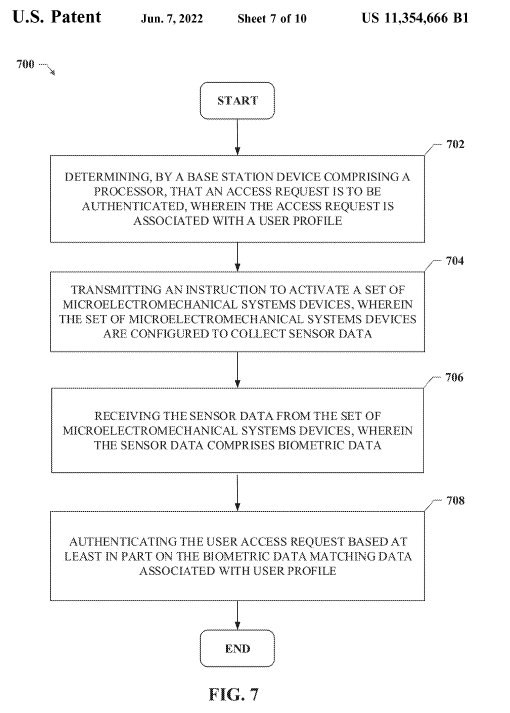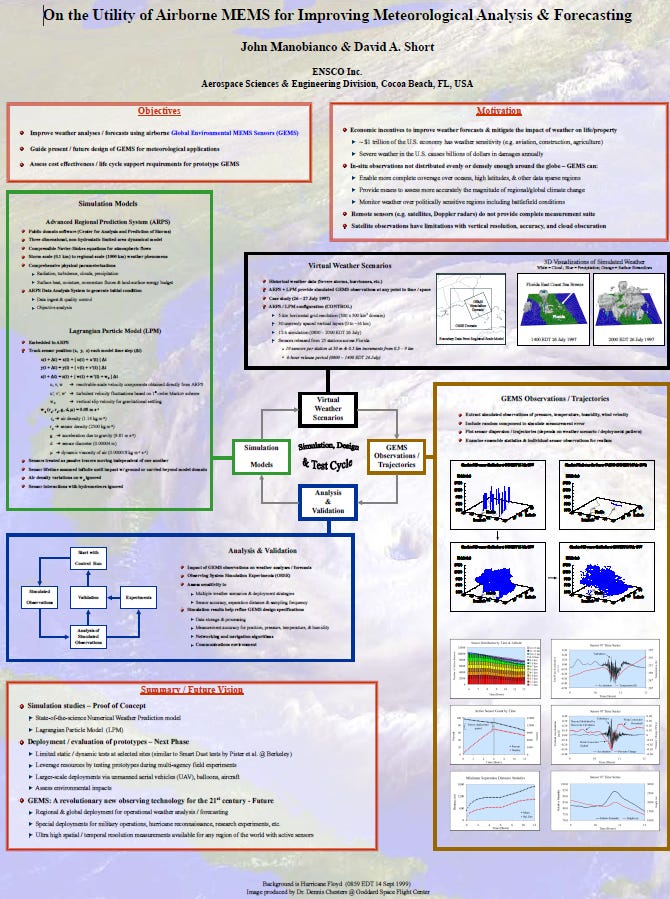Smart Dust | The Key To 4th Industrial Revolution

It's Everywhere Monitoring Everything - Healthcare, Banking, Weather, Food, Military Applications And Humans
Ana Maria Mihalcea, MD, PhD | substack.com/@anamihalceamdphd
Dr Staninger sent me some information on smart dust, so I wanted to write an update on how this technology is the basis for the 4th Industrial Revolution and the Internet of bodies bio surveillance grid. It can be inhaled and give environmental data to a computing network. Its being used in healthcare for drug delivery, for biometric authentication by banks, for military surveillance of combat zones (and civilians), for Internet of bodies, its in food, it is sprayed for meteological purposes and we just happen to inhale it - it is the invisible microsensor grid network everywhere.
Here is a 2010 article from CNN
'Smart dust' aims to monitor everything
These "smart dust" particles, as he called them, would monitor everything, acting like electronic nerve endings for the planet. Fitted with computing power, sensing equipment, wireless radios and long battery life, the smart dust would make observations and relay mountains of real-time data about people, cities and the natural environment.
The government technology website published this article in 2010 that gives a great overview of what smart dust is and how it works:
Health and Human Services Dust in the Wind
In 1997, while a professor at the University of California at Berkeley, Kris Pister proposed a project to deliver sensing, computing and networking in a millimeter-sized package. The project, called Smart Dust, was funded by DARPA the same year.
The idea was to make low-cost, battery-operated wireless sensor networks to drop over a battlefield or other areas of interest, or place them quickly and easily in a variety of buildings and structures to evaluate the situation, said Pister, who is president and CEO of Dust Inc. "You can monitor when people or vehicles go by, you can track things, whether they're enemy combatants or civilians -- there are all sorts of great things you can do if you've got the sensors to do it," he said. "It's all stuff you can do today if you spent the time and money to wire it all up, but you don't have that luxury in a battle or in a foreign country you're about to have a battle in -- you just can't get in there with a wired system."
Beginnings
A Smart Dust "mote" is a sensor-processing node -- a millimeter-sized point in a network that observes and records its surroundings. Information these motes collect varies depending on what you want to observe, said Steven Glaser, associate professor for the Department of Civil and Environmental Engineering at UC Berkeley. "It has a microcontrollor, two-way radio, buffer memory and so on and so forth, and it's dynamically reprogrammable, so you can change what it can do at a later time," he said. "It's a smart device; they have an operating system that allows devices to talk to each other, and [transfer] data without the interference from an outside boss, so it's a peer-to-peer network."
Smart Dust uses ad hoc networks, Glaser said, which means the devices set the network up themselves on the fly, and the network structure changes through time.
The network can also be set up arbitrarily, Glaser added, and because the motes or nodes are autonomous, they self-assemble into a network. Intermediate nodes help distant nodes reach the mother unit, which controls the sensor data, and is connected to a PC, known as the base station. The sensors use an open source software program for wireless networks called TinyOS to talk to each other. David Culler, a professor of computer science at UC Berkeley who directs the Intel Research laboratory at the university, wrote TinyOS.
When a new technology is announced, people tend to doubt its reliability until it is proven, which is what Culler, Glaser, Pister and everyone else with their hands in the Dust, are working on. Initially testing in the environment made the most sense because the nodes could be dispersed and collect data without affecting anyone.
"How do you go through the steps and develop a trust with new technology?" Culler said. "The natural place to start was the environment. For one thing, it doesn't move." Glaser and his graduate students, in conjunction with the Lawrence Berkeley National Laboratory, are measuring humidity in the nuclear waste repository being planned in Yucca Mountain, Nev. The device traditionally used to measure humidity in the repository is large and emits a lot of heat, Glaser said, which changes the humidity.
Because Smart Dust is so small, it can operate for long periods without wires and send data from locations where a large device wouldn't go. It was the perfect candidate. Glaser also has upcoming projects in Israel and China.
So far, the largest number of motes dispersed in an area is several hundred, Culler said, adding that development to make the networking easier is ongoing, and assembling the networks is still a fair amount of work.
Smart Dust motes are considered cheap -- a few hundred dollars each, Glaser said, but prices will lower because right now they're still considered research devices. As they become commercial, the cost will lower considerably because much of the cost is development. "The sensors can range -- let's say for vibration -- from $5 apiece to $1,000 apiece, depending on how sensitive you want them for what you need," Glaser said. "If you're looking at very strong earthquake response, and you're not interested in small tremors but real earthquakes, then the $5 piece works just fine."
The top 5 MEMS manufacturers have been changing healthcare as we know it and the MEMS sensors have been implemented everywhere:
Top 5 MEMS Technology Companies in 2023
According to Mordor Intelligence, the MEMS market is projected to grow from USD 15.50 billion in 2023 to USD 23.23 billion by 2028, with a CAGR of 8.43%. This expansion is fueled by rising demand for MEMS in diverse sectors, from automotive to consumer electronics. MEMS technology is crucial for IoT’s need for small, cost-effective sensors to monitor production and withstand tough conditions.
It plays a vital role in automation due to its sensitivity, reliability, and scalability. Challenges arise from the complex manufacturing process of these devices. The chip industry’s use of MEMS surged during the COVID-19 fight, enabling innovations in electronics, including rapid testing and SARS-CoV-2 detection techniques
Phillips discusses how precision healthcare is based on MEMS utilization and how this technology has been around for decades:
In reply, healthcare is transitioning in several ways. Patients are treated in their home environments as much as possible – a trend that was accelerated during the pandemic. Also, patients are more than ever empowered to understand and improve the condition of their own health thanks to wearable devices and online information. Personalization offers opportunities to tailor therapies to individual patients. Finally, the efficiency of healthcare is stimulated by the transition to pay for cure, rather than pay for treatment.[1] Paradoxically, these four solution paths to solve the macro societal challenges in healthcare are enabled technically at a micro-level. Several technological developments on submillimeter level offer a roadmap away from a global healthcare infarct. Some of these solutions are implemented in micro-electronic mechanical systems (MEMS) that have been around for some years, or even decades. In some application areas MEMS are expected to fulfill their promise already in the coming years.
Microelectromechanical systems (MEMS) in drug delivery
MEMS are small, integrated devices that combine electrical and mechanical components, and have been made possible by the advances in microfluidics and electronics miniaturisation. These range from simple systems with no moving parts to highly complex systems. MEMS can be aseptically manufactured using biocompatible materials, and they can be hermetically sealed. MEMS drug delivery devices generally consist of three components: drug chamber, drug release mechanism and packaging, and may incorporate sensors, channels, pumps, valves, needles, membranes and single or multiple drug reservoirs.
MEMS devices can be implantable or wearable, and have applications in chronic and long-term disease. They can deliver drugs to specific locations, and some can deliver more than one drug. Those with integrated sensors can tailor delivery rates to the patient's needs based on detection of vital signs or biomarkers.
MEMS are small and lightweight and can easily be integrated with electrical and electronic circuits. MEMS devices can be powered or non-powered. Powered MEMS have low power consumption, and may be self-powered. MEMS devices do have a number of downsides, however. They can be fragile, and may fail as a result of contamination, fatigue, friction or wear.
MEMS are being used to assess food freshness and has other applications in the food industry:
Near-Infrared Spectral MEMS Gas Sensor for Multi-Component Food Gas Detection
Smart Dust Motes were part of the implanted technology found in targeted individuals by Dr Staninger:
What Is Smart Dust And How Is it Used?
I showed the top Smart Dust contractors for the military predicted for 2025 here:
“The future GNR (Genetics, Nanotechnology, Robotics) age will come about not from the exponential explosion of computation alone but rather from the interplay and myriad synergies that will result from multiple intertwined technological advances.”4 In this complex system-of-systems world, combinations of enabling technologies produce powerful and effective technological applications. One application, from the fusion of nanotechnology, wireless sensor networks, and microelectronic mechanical systems (MEMS), is Smart Dust, networked molecular particles capable of measuring, collecting, and sending information remotely.
Here is Wells Fargo’s patent using smart dust to authenticate credit card users:
Systems and methods that facilitate authenticating a user making a payment using microelectromechanical systems ( MEMs ) devices ( i.e. , smart dust ) . The MEMs devices may have sensors that collect data and transfer it to a base station device . The MEMs devices can collect sensor data , including biometric data and / or capture images of the person . The MEMs can also collect sensor data such as audio data , optical data , temperature data , blood pressure pressure data , and motion data and compare it to data associated with a user profile to determine that the person making the payment is the same person associated with the user profile . Once the person's identity has been confirmed , and thus authenticated , the payment request can be confirmed and payment made , via either the mobile device or credit card .

MEMS also have been used for weather forcasting. Note that we inhale the MEMS that are being sprayed.

They are the same microelectronic technology for total surveillance that I have shown many times even in COVID19 unvaccinated blood - call them nano or microrobots it is all the same technology with different applications.
Klaus Schwab told us that the smart dust is organizing itself in our bodies. It will change what it is to be human.

Original Article: https://anamihalceamdphd.substack.com/p/smart-dust-the-key-to-4th-industrial
Related:



Comments ()